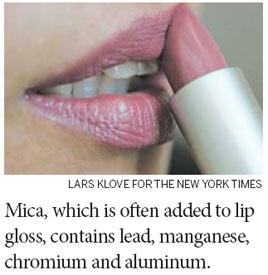Is danger lurking in lipstick?
Updated: 2013-09-08 07:39
By Deborah Blum(The New York Times)
|
|||||||
A soft pink, a glowing red, even a cyanotic purple - millions of women and girls apply lipstick every day. And not just once: some style-conscious users touch up their color more than 20 times a day, according to a recent study. But are they also exposing themselves to toxic metals?
Most lipsticks contain at least a trace of lead, researchers have shown. But a new study finds that a wide range of brands contain other metals, from cadmium to aluminum. Now experts are raising questions about what happens if these metals are absorbed on a daily basis.
"It matters because this is a chronic long-term issue, not a short-term exposure," said Katharine Hammond of the University of California at Berkeley and the lead author of the new analysis. "We're not saying that anyone needs to panic. We're saying let's not be complacent, that these are metals known to affect health."
The issue first came to public attention in 2007 with a report on lead contamination in lipsticks by the Campaign for Safe Cosmetics. The United States Food and Drug Administration published a follow-up in 2011, finding traces of lead in 400 lipsticks.

Both the F.D.A. and the cosmetics industry insist that the average lead level found, just above 1 part per million, poses no real or unusual health risk. "Metals are ubiquitous," said Linda Loretz, chief toxicologist for the Personal Care Products Council, an industry association. "And this is a very small amount, too small to be a safety issue."
But lead tends to accumulate in the body, noted Dr. Sean Palfrey, medical director of the lead poisoning prevention program at Boston University Medical Center. He also noted that the Centers for Disease Control and Prevention in the United States "acknowledged last year that no level of lead is really safe."
Beyond lead, Dr. Hammond's study, published in May in the journal Environmental Health Perspectives, found traces of cadmium, cobalt, aluminum, titanium, manganese, chromium, copper and nickel in 24 lip glosses and eight lipstick brands.
The average concentration of aluminum in the lip products, for instance, topped 5,000 parts per million.
Aluminum is added to lipsticks as a stabilizer, said Ms. Loretz: "It keeps colors from bleeding." Titanium oxide is used as a whitening agent, softening reds into pinks. Both uses are approved by the F.D.A. But all of the other metals noted by Dr. Hammond are probably unwanted contaminants, Ms. Loretz said.

For example, manufacturers often use glittery, microscopic flakes of mica, a naturally occurring mineral formation, to add shine to lip gloss. Mica routinely contains such metals as lead, manganese, chromium and aluminum. And there is some indication that more intense lipstick colors may carry a bigger metallic load because of contamination in pigments.
Some metals are undoubtedly absorbed through mucosal tissues, Dr. Palfrey said.
Dr. Hammond recommends that consumers take a common-sense approach: For starters, don't let young children play with lipstick.
She said, "Treat it like something dangerous, because if they eat it we are talking about a comparatively large level of metals going into a small body."
The New York Times
(China Daily 09/08/2013 page11)